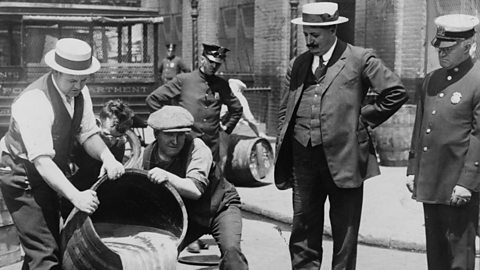End of an era
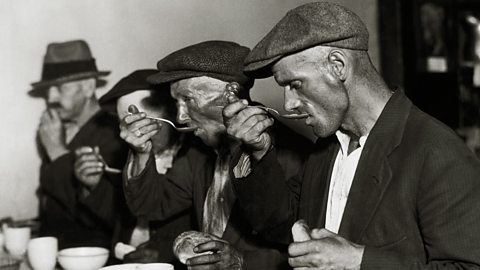
In October 1929, the 'Roaring Twenties' came to a dramatic end and the USA economy went into a period of deep economic and social distress called The Great Depression.
Its impact was felt throughout America.
The closure of firms and increased unemployment
Unemployment was increasing even before the The Wall Street CrashShare prices in America plunged in October 1929. Millions of people lost their savings and the world fell into an economic depression. and had reached 1.6 million.
Originally, it hit workers in the old industries, for example coal mining, textile industryBusinesses that turn raw materials into sheets of fabric and clothes., railroads and shipbuilding, but by 1929 it also affected workers in the consumer goodsProducts that individuals purchase for their own use or benefit. industries.
Businesses were failing because of overproduction of goods and underconsumption.
Banks were refusing to lend money to companies to help them survive because of a lack of confidence in the economy.
The cutbacks in production led to unemployment, which in turn reduced demand for goods and created further unemployment.
The Great DepressionA global economic crisis that started in 1929 in the USA. It led to mass unemployment and hardship throughout the 1930s. saw many manufacturing businesses close.
Widespread unemployment created a cycle of problems that kept feeding into one another and making the problems even worse.
Cycle of problems caused by unemployment
- Factory closures lead to unemployment.
- Unemployed people lose income and experience poverty.
- They cannot afford consumer goods.
- Factories cannot sell goods, suffer overproduction and lose money.
- Factories have to close.
The effect on workers
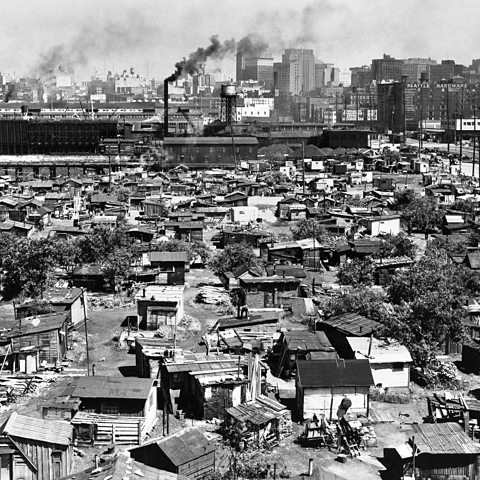
For many workers, the Great DepressionA global economic crisis that started in 1929 in the USA. It led to mass unemployment and hardship throughout the 1930s. was a period of misery and destitution.
America had no social securityFinancial assistance given by the state to individuals with a very low income or none at all. system and so those without work had to fend for themselves.
Unemployment increased: It rose from 1.6 million in 1929 to 14 million in 1933. This was an increase from 3 per cent to 25 per cent of the workforce.
- People were desperate for work. For example, in 1930 there were 6,000 men on the streets of New York trying to survive by selling apples. In Cleveland, a city dependent on the steel industry, over 50% of men were unemployed.
Wages fell: As competition for jobs increased, even those in work suffered.
- Employers reduced wages and increased hours.
- Some government employees, such as teachers, were not paid when city councils went bankrupt.
Starvation grew: Workers struggled to buy even the basics, such as food.
- In 1931, about 100 died directly of starvation in New York hospitals.
- Many more died of illnesses related to a lack of nutritionAll the contents of food and drink that our bodies need to grow and be healthy.. One third of children in New York were malnourished.
±«Óătvlessness soared: By 1932, over 250,000 people could not pay their mortgageA mortgage is a type of loan. It is usually a large amount of money used to pay for a property..
- Those who fell behind with their mortgages or their rent were evicted.
- Most ended up either on the streets sleeping or sleeping on park benches.
Shanty towns of cardboard and corrugated iron sprang up on the edges of cities. They were nicknamed Hoovervilles to express the frustration people had about the lack of support coming from President Hoover.
Vagrants: A large number of men (estimated at two million in 1932) became hoboA worker who travelled around the country looking for work. , travelling around America, living in tents by railway tracks or in freight wagons.
- Some deliberately got arrested because a night in jail meant warmth, a bed and food.
Reliance on charity and relief schemes escalated: America did not have unemployment benefits. It was left to towns and cities to organise temporary homes, food and clothing for the poor.
- Long queues for bread handouts were common.
- Many state governments went bankruptWhen an institution, organisation, company or person runs out of money..
- Hoover eventually had to lend billions of dollars of government money to them in 1932 to fund public works schemes.
Angry protests: Demonstrations, by both the unemployed and employed, at the lack of action by the government became violent.
- In 1930, a rally of unemployed people became a riot as police charged the crowd.
- There were strikes and bitter clashes in many American cities because of starvation level wages.

Bonus Army incident
The biggest protest was by the Bonus Army in 1932.
These were World War One veteranAn ex-member of the armed forces. supporting a bill going through CongressThe legislative body of the US government, made up of the Senate and the House of Representatives. which would give them early payment of their $1,000 war bonuses.
They were not due to receive them until 1945.
With their wives and children, 15,000 of them set up a camp on Anacostia Flats, Washington to support a Bill that was going through Congress for early payment.
Hoover accused them of being communistSomeone who believes in the political ideology of communism, a system of running a country in which all means of production such as tools, factories and raw materials, are owned by the community as a whole. Private property does not exist and each individual contributes according to their ability and receives according to their needs. This means there is no hierarchy of social class. and ordered their removal.
They were dispersed by armed troops, tanks and tear gas on the command of General MacArthur.
Two veterans and two babies died - many children were injured.
Effects of tariffs and overproduction
Farmers had missed out on the economic boomA period when the economy expands and grows. in the 1920s.
Their income was very low due to overproduction of their crops and underconsumption by the public of their produce.
Farmers had also been encouraged to take out loans to modernise.
Before World War One, about 90% of grain was used to make alcohol.
After the introduction of ProhibitionA name given to a period in US history between 1920-1933 when alcohol was banned. there was a lot of surplusWhen there is more of something than is needed. grain throughout the 1920s.
One alternative was to sell the surplus produce abroad, but many countries had placed tariffA tax or charge placed on imported or exported goods and services. on American goods in retaliation for protectionismProtectionism is the process of protecting domestic industries by adding tariffs or taxes onto imports..
This made exporting the grain very difficult, which led to a substantial drop in prices.
The price of cotton fell by an enormous 70% and the price of wheat decreased from 103 cents per ton in 1929 to 38 cents per ton in 1933.
sharecroppersFarmers who had to pay to use land by giving a proportion of their produce to the owner. was particularly common in the cotton industry and they were devastated by its collapse.
Hardship for farmers and sharecroppers
- The drop in incomes pushed many farmers into debt. Farmers had also been encouraged to take out loans to modernise.
- There was a sharp rise in interest rates The amount an individual is charged for borrowing money. The rate is an annual percentage of the loan. between 1929 and 1931 which meant they had to pay back an extra amount to the banks.
- A lot of farmers couldnât repay their loans or their mortgageA mortgage is a type of loan. It is usually a large amount of money used to pay for a property..
- As a result, over three quarter of a million farmers lost their land.
- The collapse in agriculture didnât just effect the landowners but also the labourers and sharecroppersFarmers who had to pay to use land by giving a proportion of their produce to the owner. who relied on the land for their livelihood.
The Dust Bowl and the effects in the Midwest
- The Midwest area of the US had originally been grazingWhen animals eat grass. Farmers put animals like cows in fields to graze., but during World War One increased demand for food meant it was used for intensive arable farmingUse of land to grow crops., which left the exposed soil vulnerable to soil erosionWhen soil is taken away by things like the wind and water. Loss of soil through erosion makes it harder to grow crops..
- From 1930 onwards, farmers in the Midwest were hit by a series of droughtA long period of low rainfall that creates a major shortage of water..
- The poor soil created huge clouds of dust which swept across the land, creating a dust bowl of 20 million hectares of land. Clouds could travel as far as New York.
- In 1935, huge rains destroyed crops, washed away topsoil and ruined harvestA process or period of gathering crops..
- There were also invasions of pests such as grasshoppers, which meant crops had to be destroyed.
Impact on the lives of farmers
Farming families from the southern and mid-western states, particularly Oklahoma and Arkansas, migrated west to California in the hope of better land and employment. However, it was not the land of plenty for which they hoped.
- Finding work was difficult, and Californian employers took advantage of the migrants' desperation to work.
- Many had to live in filthy, unhygienic camps where diseases were rife.
- These newcomers, who the locals referred to as Okies and Arkies, were often resented. This was because they were competing with Californians for scarce work.
Many others became hobos, homeless drifters who rode the freight trains of the country, in search of work.
- There were over one and a half million hobos and 20 per cent of them were children.
sharecroppersFarmers who had to pay to use land by giving a proportion of their produce to the owner., the majority of whom were black Americans, either did not receive their portion of the crop or were made redundant.
- Many migrated to northern towns in search of work, but unemployment and discriminationTreating people differently on the basis of a particular characteristic, such as race, religion or sex. were high there too.
As frustration mounted at the lack of government help, there was unrest in the countryside, particularly when officials came to forecloseTo repossess a property that was bought with a loan or mortgage because the owner can no longer make the payments as previously agreed or at all. on farms.
Farmers even blockaded towns, refusing to let food in until they were paid for it, as happened in Sioux City.
President Hoover and the Great Depression

Herbert Hoover, a Republican PartyOne of the two major American political parties. Republicans tend to hold a more conservative viewpoint on politics and society., was President from 1929 to 1933.
He came into office having won a landslide victory and believing the boom of the 1920s would continue.
However, after just eight months in office, the stock marketA centralised market where business shares are traded. crashed and he had to deal with the worst economic depression in Americaâs history.
Initially, he thought the crash would be short-lived.
Republican values
Hoover had very fixed views on the responsibilities of the government.
He believed in laissez-faire and 'rugged individualism'.
Laissez-faire meant the government would limit its intervention in the economy.
Hoover believed that too much interference would mean economic normality would not return.
He even blocked the Garner-Wagner Relief Bill, a plan by Congress to spend government money to create jobs.
Rugged individualism meant people were expected to overcome problems and succeed by their own efforts.
They were not to depend on help from the government.
Hoover thought aid would make people lazy and damage their morals.
He was a self-made millionaire and expected others to be self-reliant.
Policies
Voluntarism: Hoover felt that whilst it was improper for the federal government in Washington to give handouts to the poor, help for the homeless and hungry could come from charities, businesses, churches and local state governments.
Public Work Schemes: Public work schemes are construction projects that are funded by the government that help to create jobs. Hoover spent $1.3 million dollars to fund work scheme programmes, the most successful of which was the Hoover Dam. It provided farmers in Arizona and Nevada with a regular supply of water, prevented flooding and was used to generate hydroelectric power (HEP)Energy generated from fast-flowing water..
The Presidentâs Organisation on Unemployment Relief (POUR): The Presidentâs Organisation on Unemployment Relief (POUR) was set up in 1931. Its purpose was to co-ordinate local welfare agencies, without spending government money. It only lasted until 1932.
The Hawley-Smoot Act 1930: In 1930, Hoover introduced the Hawley-Smoot Act which increased tariffA tax or charge placed on imported or exported goods and services. to 60 per cent on imported manufactured items. This aimed to encourage consumers to buy more home-produced goods by making foreign goods even more expensive. It was hoped that this would help out struggling industries.
The Reconstruction Finance Corporation: The Reconstruction Finance Corporation (RFC) was established in 1932. This gave $2 billion dollars in loans to assist businesses, banks and insurance companies.
The Federal Farm Board 1932: The Federal Farm Board provided loans to farmers for seed and fertilisers. It also bought $500 million worth of surplus food to help keep prices up.
The impact of Hooverâs policies
Hoover had completely underestimated the length and the severity of the Great Depression.
It wasnât the normal cycle of âboom and bustâ, but instead a complete collapse in the economy.
voluntarismThe practice of supporting churches, schools, hospitals, etc., by voluntary contributions or aid instead of relying on government assistance. was simply not enough to cope with the problem and the POURThe Presidentâs Organisation on Unemployment Relief (POUR) was set up in 1931. Its purpose was to co-ordinate local welfare agencies, without spending government money. It only lasted until 1932. programme failed by 1932 because it was money rather than organisation that was needed.
The Hawley-Smoot Act, 1930US act which raised import duties in order to protect American businessmen and farmers. only served to make European countries retaliate, meaning that American companies and farmers couldnât export their surplusWhen there is more of something than is needed. goods at a time when it was needed.
Whilst the Reconstruction Finance Corporation and Farm Board loans were welcome, they simply werenât enough given the massive scale of the Great DepressionA global economic crisis that started in 1929 in the USA. It led to mass unemployment and hardship throughout the 1930s..
On farmers
Agriculture continued to decline under Hoover and there was great hardship.
Prices remained so low farmers could not afford to harvest their crops.
They left the crops, like wheat and fruit, to rot in the fields and farm animals were killed instead of being taken to market.
40 per cent of farms were mortgageA mortgage is a type of loan. It is usually a large amount of money used to pay for a property. to banks.
Evictions for non-payment of mortgages increased.
On workers
Unemployment increased under Hoover from 1.6 million to 14 million.
Even for those in work, wages remained low because businesses were struggling to survive.
The US Steel Corporation cut salaries by 10% in 1931.
Thousands were living in the HoovervillesShanty towns, which are large settlements consisting of very poor quality housing, built during the Great Depression that took their name after President Herbert Hoover..
On businesses
Industrial production continued to drop.
It decreased by 45 per cent between 1929 and 1932.
House-building fell by 92 per cent between 1929 and 1932.
Businesses continued to go bankruptWhen an institution, organisation, company or person runs out of money., especially banks.
From 1929 to 1932, 5000 banks, which tended to be too small and unregulated, went out of business.
In New York, 10,000 of the 29,000 manufacturing firms closed.
On state governments
Hoover gave $300 million to the states through the 1932 Emergency Relief Act to provide support for the unemployed, but only $30 million was used by the Republican states because they believed more strongly than Hoover in rugged individualismA belief that people should overcome problems and succeed by their own efforts. They should not depend on help from the government..
The 1932 Presidential Election
In the 1932 presidential election, Hoover would be up against Franklin D Roosevelt of the Democratic PartyPolitical party in the United States. Democrats tend to hold a more liberal viewpoint on politics and society..
They were two contrasting choices.
In Hooverâs election campaign, his speeches increased his unpopularity.
Voters disliked his emphasis on self-reliance and the need for neighbours to help each other, not the government.
People did not believe his promise that, âProsperity is just around the cornerâ.
Franklin D Rooseveltâs appeal
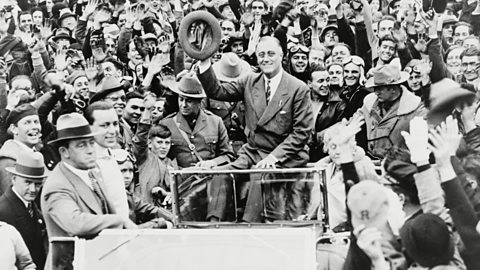
In contrast to Hoover, Roosevelt ran a positive and energetic campaign.
He travelled around America to bring his message to ordinary people, in spite of his disability from polioA serious infectious disease that can cause permanent paralysis..
He was much more approachable and charismatic than Hoover, and a more confident public speaker.
Roosevelt appealed to the electorate in a number of ways.
He had already helped the poor as Governor of New York State by setting up the first state-run relief scheme. This made him popular with the workers, if not businessmen.
His ideas in the election campaign seemed radically different from Hooverâs rugged individualismA belief that people should overcome problems and succeed by their own efforts. They should not depend on help from the government. and were therefore popular with the voters.
Roosevelt promised a âNew Dealâ with the American people under which the government would intervene in the economy to try and solve the depression.
Hoover v Roosevelt
Hoover
- Often thought to be remote and aloof.
- He was a rich millionaire.
- A poor communicator with the public.
- He still emphasised the role of the individual in solving problems rather than the government.
- Had done âtoo little, too late' to address the depression and his policies were ineffective.
Roosevelt
- Had a warm personality and although from a rich background, he was dealing with the personal tragedy of polioA serious infectious disease that can cause permanent paralysis. which confined him to a wheelchair.
- A very good communicator who ran an energetic campaign.
- He promised government help and a âNew Dealâ between the government and the people.
- Promised to fight the depression like he would a war.
Quiz: Hoover or Roosevelt?
Election result
With President Hoover and Republican PartyOne of the two major American political parties. Republicans tend to hold a more conservative viewpoint on politics and society. being blamed for the Great DepressionA global economic crisis that started in 1929 in the USA. It led to mass unemployment and hardship throughout the 1930s., Roosevelt won the election in a huge victory.
Only six out of the 48 states voted for Hoover.
Test your knowledge
More on Life in the United States of America, 1920-33
Find out more by working through a topic
- count1 of 9
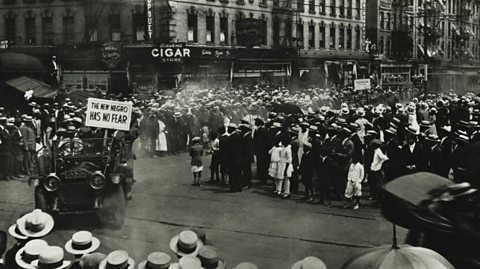
- count2 of 9
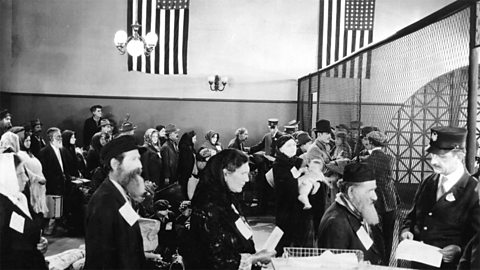
- count3 of 9

- count4 of 9
